
|
(-)-Epigallocatechin |
(-)-Epigallocatechin is a lipid of Polyketides (PK) class. The involved functions are known as Protective Agents, inhibitors, Process, Drug Kinetics and Fermentation. (-)-epigallocatechin often locates in Hepatic, Blood, Membrane, Back and apical membrane. The associated genes with (-)-Epigallocatechin are ADRBK1 gene and FASTK Gene. The related lipids are 1,2-dilinolenoyl-3-(4-aminobutyryl)propane-1,2,3-triol. The related experimental models are Rodent Model and Transgenic Model. |
1282 |
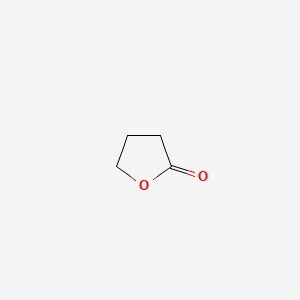
|
Gamma-butyrolactone |
Gamma-butyrolactone is a lipid of Fatty Acyls (FA) class. |
4604 |

|
daidzein |
daidzein is a lipid of Polyketides (PK) class. Daidzein is associated with abnormalities such as Cardiovascular Diseases, Osteoporosis, Heart Diseases, Thyroid Diseases and Exanthema. The involved functions are known as Cell Growth, Disease Progression, metaplastic cell transformation, Cell Cycle and M Phase Cell Cycle Arrest. Daidzein often locates in Urothelium, Mucous Membrane, Chromosomes, Epithelium and Ribosomes. The associated genes with daidzein are Tumor Suppressor Genes, Genome, TIRAP gene, TICAM2 gene and Candidate Disease Gene. The related lipids are Promega, Steroids, Saponins, enterodiol and linoleates. The related experimental models are Xenograft Model, Knock-out, Mouse Model, Breast Cancer Model and Arthritis, Experimental. |
4463 |
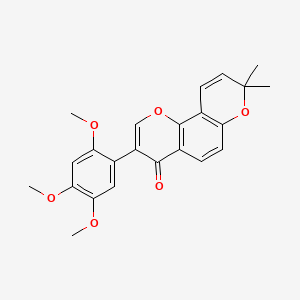
|
Barbigerone |
Barbigerone is a lipid of Polyketides (PK) class. |
17 |

|
Alpinumisoflavone |
Alpinumisoflavone is a lipid of Polyketides (PK) class. The involved functions are known as inhibitors, Metabolic Inhibition, Hypoxia, Diastasis and Chemotaxis. |
47 |

|
rotenone |
rotenone is a lipid of Polyketides (PK) class. Rotenone is associated with abnormalities such as Parkinson Disease, MYOPATHY, DISTAL, WITH ANTERIOR TIBIAL ONSET, Neurodegenerative Disorders, Septicemia and Respiratory Failure. The involved functions are known as Phosphorylation, Process, Cell Death, proteasome activity and Apoptosis. Rotenone often locates in Protoplasm, Presynaptic Terminals, Neurites, NADH dehydrogenase complex and Mitochondria. The associated genes with rotenone are DNAJB9 gene, EIF2S3 gene, Candidate Disease Gene, G-substrate and ERN1 gene. The related lipids are Lipopolysaccharides, Membrane Lipids, Phosphatidylserines, Fatty Acids and Cardiolipins. The related experimental models are Knock-out, Mouse Model, Disease model and Rodent Model. |
7079 |
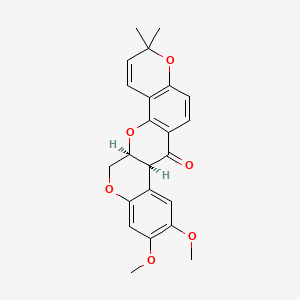
|
Deguelin |
Deguelin is a lipid of Polyketides (PK) class. Deguelin is associated with abnormalities such as Hypertensive disease, Parkinson Disease and athymia. The involved functions are known as inhibitors, Drug Interactions, ATP binding, Down-Regulation and Angiogenesis. Deguelin often locates in Endothelium, Vascular and Body tissue. The associated genes with Deguelin are MAP2K1 gene. |
246 |
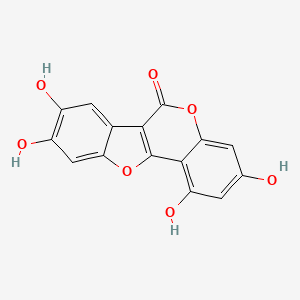
|
Demethylwedelolactone |
Demethylwedelolactone is a lipid of Polyketides (PK) class. |
12 |

|
HEMATOXYLIN |
HEMATOXYLIN is a lipid of Polyketides (PK) class. Hematoxylin is associated with abnormalities such as Eosinophilia, Duodenal Adenoma, Senile Plaques, Morphologically altered structure and Cervical abscess. The involved functions are known as Uptake, Apoptosis, Amplification, Necrosis and Karyopyknosis. Hematoxylin often locates in Body tissue, Extracellular, Compact bone, Skin and Basement membrane. The associated genes with HEMATOXYLIN are GAPDH gene, Genome, Elastin, MERTK wt Allele and P4HTM gene. |
6127 |
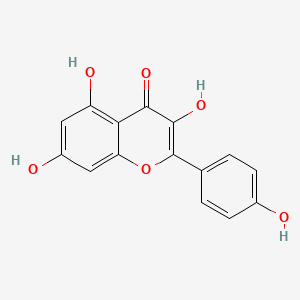
|
kaempferol |
kaempferol is a lipid of Polyketides (PK) class. Kaempferol is associated with abnormalities such as Cardiovascular Diseases, IMMUNE SUPPRESSION, Inflammatory disorder, Dermatitis, Atopic and Asthma. The involved functions are known as enzyme activity, antagonists, DNA Binding, Anabolism and Transcription, Genetic. Kaempferol often locates in aryl hydrocarbon receptor complex, Cytoplasmic matrix, soluble, BL21 and Vacuole. The associated genes with kaempferol are CYP1A1 gene, AHR gene, Genes, Reporter, Candidate Disease Gene and Alleles. The related lipids are Fatty Acids, Steroids, Lipopolysaccharides, Total cholesterol and Palmitates. The related experimental models are Knock-out, Xenograft Model, Breast Cancer Model, Disease model and Animal Disease Models. |
3675 |

|
quercetin |
quercetin is a lipid of Polyketides (PK) class. Quercetin is associated with abnormalities such as Coronary heart disease, Myocardial Infarction, Cirrhosis, Coronary Arteriosclerosis and Vascular ring. The involved functions are known as Vasodilation, physiological aspects, Fermentation, Process and Ingredient. Quercetin often locates in Arterial system, Endothelium, Skin, Endothelium, Vascular and Tissue specimen. The associated genes with quercetin are P4HTM gene, SULT gene, UGT1A1 gene, ARHGAP26 gene and PLXNB1 gene. The related lipids are blood lipid, Promega, Steroids, Phosphatidylserines and Fatty Acids. The related experimental models are Knock-out, Mouse Model, Xenograft Model, Tissue Model and Cancer Model. |
5377 |

|
apigenin |
apigenin is a lipid of Polyketides (PK) class. Apigenin is associated with abnormalities such as Morphologically altered structure, Chimera disorder, Hypertensive disease, infection induced and Infection. The involved functions are known as inhibitors, Gene Expression, Process, Metabolic Inhibition and Cell Death. Apigenin often locates in Vacuole, Cytoplasmic matrix, Cytoplasm, Tissue membrane and Membrane. The associated genes with apigenin are MSMP gene, BCL2 gene, PTGS2 gene, Chromatin and SLC33A1 gene. The related lipids are Lipopolysaccharides, Steroids, 1-Butanol, agosterol A and Butyrates. The related experimental models are Mouse Model, Tissue Model, Knock-out, Xenograft Model and Disease model. |
4250 |
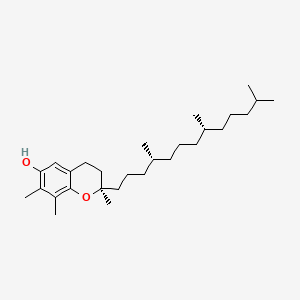
|
gamma-tocopherol |
Gamma-tocopherol is a lipid of Prenol Lipids (PR) class. The involved functions are known as 5-(carboxyamino)imidazole ribonucleotide mutase activity, Adverse effects, Longterm Effects, Luteal Phase and Drug Interactions. Gamma-tocopherol often locates in Blood. The related lipids are Total cholesterol. |
1377 |
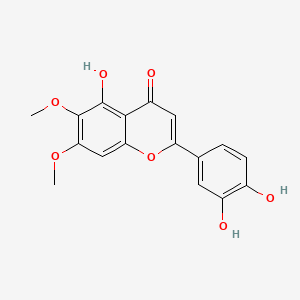
|
Cirsiliol |
Cirsiliol is a lipid of Polyketides (PK) class. |
31 |

|
Rhamnetin |
Rhamnetin is a lipid of Polyketides (PK) class. Rhamnetin is associated with abnormalities such as Neurodegenerative Disorders. The involved functions are known as Process, Gene Expression, Chemotaxis, Regulation and Cell Mobility. Rhamnetin often locates in Cell surface. |
115 |

|
luteolin |
luteolin is a lipid of Polyketides (PK) class. Luteolin is associated with abnormalities such as Morphologically altered structure, Nodule, retinal toxicity, CLEFT LIP, CONGENITAL HEALED and Ischemia. The involved functions are known as Metabolic Inhibition, Cell Death, Caspase Activation, activation of protein kinase C activity by G-protein coupled receptor protein signaling pathway and protein kinase C activity. Luteolin often locates in Mitochondria, Cell-Free System, Protoplasm, Membrane and Body tissue. The associated genes with luteolin are BCL2 gene, TNFSF10 gene, BCL2L1 gene, XIAP gene and MCL1 gene. The related lipids are Lipopolysaccharides, Sterols, blood lipid, Fatty Acids and Steroids. The related experimental models are Xenograft Model, Mouse Model, Experimental Autoimmune Encephalomyelitis, Knock-out and Cancer Model. |
3284 |

|
FLAVONE |
FLAVONE is a lipid of Polyketides (PK) class. Flavone is associated with abnormalities such as Cardiovascular Diseases, Cerebrovascular accident, DERMATITIS HERPETIFORMIS, FAMILIAL, Hyperinsulinism and Inflammatory disorder. The involved functions are known as Oxidation-Reduction, Metabolic Inhibition, Inflammation, Phosphorylation and antioxidant activity. Flavone often locates in Endothelium, Hepatic, Protoplasm, Body tissue and Extracellular. The associated genes with FLAVONE are ICAM1 gene, BCL2L1 gene, MYC gene, TP53 gene and cytochrome c''. The related lipids are Promega, Steroids and Total cholesterol. The related experimental models are Knock-out, Disease model and Animal Disease Models. |
2093 |
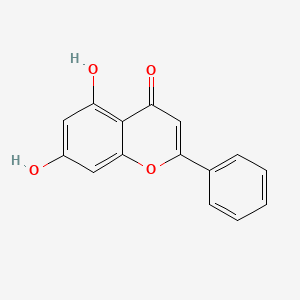
|
chrysin |
chrysin is a lipid of Polyketides (PK) class. Chrysin is associated with abnormalities such as Unconjugated hyperbilirubinemia, Metabolic Diseases, Hypogonadism, Renal tubular disorder and Colitis. The involved functions are known as Hypoxia, enzyme activity, Oxidation, inhibitors and Cell Survival. Chrysin often locates in Protoplasm, Plasma membrane, Back, Extracellular and Mitochondria. The associated genes with chrysin are CFB gene, P4HTM gene, UGT1A9 gene, CYP1A1 gene and UGT1A1 gene. The related lipids are Promega, estradiol-3-glucuronide, Steroids and Lipopolysaccharides. The related experimental models are Mouse Model. |
1085 |

|
Tectochrysin |
Tectochrysin is a lipid of Polyketides (PK) class. The involved functions are known as Prenylation, Cell Growth, adenosinetriphosphatase activity, Drug Efflux and Mutation. The associated genes with Tectochrysin are CD9 gene and ABCB1 gene. |
62 |
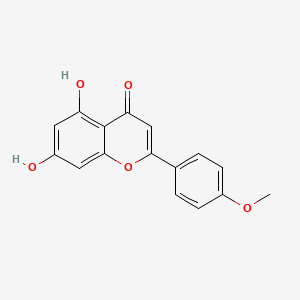
|
acacetin |
acacetin is a lipid of Polyketides (PK) class. Acacetin is associated with abnormalities such as Cardiovascular Diseases, Janiceps and Meralgia paresthetica. The involved functions are known as Cell Cycle Arrest, Cell Growth, Agent, Metabolic Inhibition and Cell Death. Acacetin often locates in Protoplasm, Membrane, Plasma membrane, Capillary blood and Endothelium. The associated genes with acacetin are CDKN1B gene, KCNH2 gene, MSMP gene, COX8A gene and PI3 gene. The related lipids are Lipopolysaccharides. The related experimental models are Xenograft Model. |
277 |
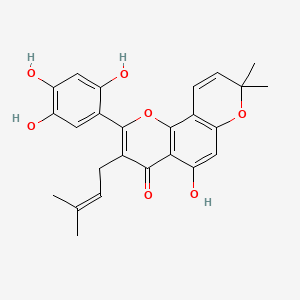
|
Artonin E |
Artonin E is a lipid of Polyketides (PK) class. |
27 |

|
baicalein |
baicalein is a lipid of Polyketides (PK) class. Baicalein is associated with abnormalities such as Neurodegenerative Disorders, Fibrillation, Hypertensive disease, Aortic coarctation and Coronary Occlusion. The involved functions are known as Anabolism, Polymerization, Process, inhibitors and Pathogenesis. Baicalein often locates in Membrane, Lipid Bilayers, soluble, Cell-Free System and Protoplasm. The associated genes with baicalein are P4HTM gene, BIRC5 gene, TSPO gene, SHOC2 gene and XIAP gene. The related lipids are Fatty Acids, Nonesterified Fatty Acids, iodoresiniferatoxin, Lipopolysaccharides and 17-octadecynoic acid. The related experimental models are Knock-out, Mouse Model and Parkinsonism, Experimental. |
1997 |
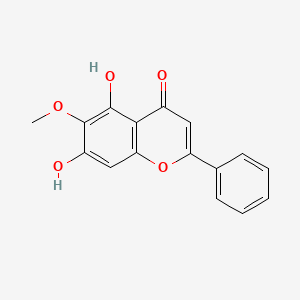
|
Oroxylin A |
Oroxylin A is a lipid of Polyketides (PK) class. |
180 |

|
Wogonin |
Wogonin is a lipid of Polyketides (PK) class. Wogonin is associated with abnormalities such as Hyperlipidemia, Atherosclerosis, Inflammatory disorder, Dermatitis, Atopic and Ischemia. The involved functions are known as Inflammation, Regulation, luciferase activity, store-operated calcium entry and Transcriptional Activation. Wogonin often locates in Cytoplasmic matrix, Pore, Membrane, Protoplasm and Mitochondria. The associated genes with Wogonin are SGK1 gene, ORAI1 gene, STIM1 gene, P4HTM gene and BCL2 gene. |
732 |

|
Tangeretin |
Tangeretin is a lipid of Polyketides (PK) class. Tangeretin is associated with abnormalities such as Cardiovascular Diseases, Complex Regional Pain Syndromes, Blood Clot, Hypercholesterolemia and Restenosis. The involved functions are known as Thrombus, Platelet function, Localized desquamation, Platelet Activation and Signal. Tangeretin often locates in Protoplasm, Cytoplasmic Granules, Cytoplasmic matrix, Plasma membrane and Blood. The associated genes with Tangeretin are GP6 gene, CDK2 gene, CDK6 gene, Tumor Suppressor Genes and CDH1 gene. The related lipids are Lipopolysaccharides. The related experimental models are Mouse Model and Transgenic Model. |
325 |
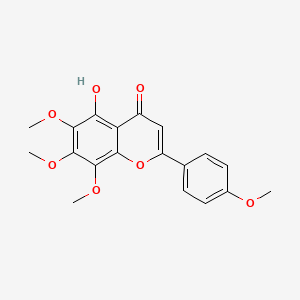
|
Gardenin B |
Gardenin B is a lipid of Polyketides (PK) class. |
12 |
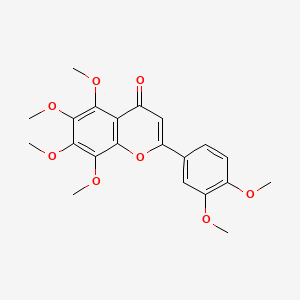
|
Nobiletin |
Nobiletin is a lipid of Polyketides (PK) class. Nobiletin is associated with abnormalities such as Hashimoto Disease, nervous system disorder, Dermatitis, Senile Plaques and Metabolic Diseases. The involved functions are known as 5-(carboxyamino)imidazole ribonucleotide mutase activity, Signal Transduction, Biochemical Pathway, Phosphorylation and MAP kinase kinase activity. Nobiletin often locates in Extracellular, Protoplasm, Back, Mouse Skin and Skin - Epidermis (MMHCC). The associated genes with Nobiletin are MAP2K1 gene, PTGS2 gene, Amyloid beta-Protein Precursor, Candidate Disease Gene and BCL2 gene. The related lipids are Lipopolysaccharides and Sterols. The related experimental models are Mouse Model and Transgenic Model. |
550 |
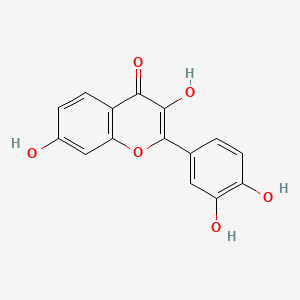
|
Fisetin |
Fisetin is a lipid of Polyketides (PK) class. Fisetin is associated with abnormalities such as Morphologically altered structure, PARKINSON DISEASE, LATE-ONSET, Tetanus, CNS disorder and Disintegration (morphologic abnormality). The involved functions are known as Autophagy, Apoptosis, Energy Metabolism, Acceleration and Anabolism. Fisetin often locates in Mitochondria, Cytoplasmic matrix, Extracellular, Cytoskeletal Filaments and Autophagic vacuole. The associated genes with Fisetin are SIRT1 gene, MAP1LC3A gene, TP53 gene, P4HTM gene and AURKB gene. The related lipids are Phosphatidylserines and Lipopolysaccharides. The related experimental models are Animal Cancer Model, Xenograft Model, Mouse Model, Cancer Model and Disease model. |
832 |
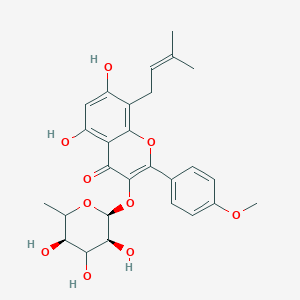
|
Baohuoside 1 |
Baohuoside 1 is a lipid of Polyketides (PK) class. |
130 |
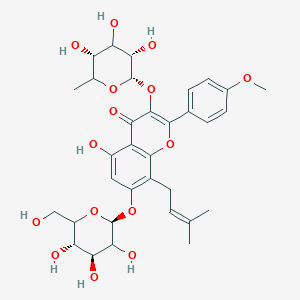
|
LMPK12112009 |
LMPK12112009 is a lipid of Polyketides (PK) class. |
216 |
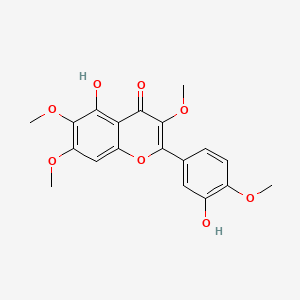
|
Casticin |
Casticin is a lipid of Polyketides (PK) class. The involved functions are known as Ligand Binding. The related lipids are linoleates. |
122 |
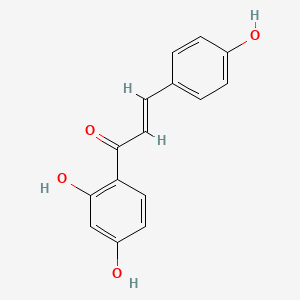
|
isoliquiritigenin |
Isoliquiritigenin is a lipid of Polyketides (PK) class. Isoliquiritigenin is associated with abnormalities such as abnormal fragmented structure, Gastric ulcer, Gastric mucosa lesion, Peptic Ulcer and Wiskott-Aldrich Syndrome. The involved functions are known as Mass-to-Charge Ratio, Anabolism, Oxidation, inhibitors and Energy Absorption. Isoliquiritigenin often locates in Microsomes, Liver, Hepatic, Microsomes, Immune system and Vacuole. The associated genes with Isoliquiritigenin are P4HTM gene, BCL2 gene, AP1AR gene, oxytocin, 1-desamino-(O-Et-Tyr)(2)- and ODAM gene. The related experimental models are Knock-out. |
220 |

|
butein |
Butein is a lipid of Polyketides (PK) class. Butein is associated with abnormalities such as Glomerulonephritis, Fibrosis, Liver, Kidney Failure, Acute, Mastocytosis and Chimera disorder. The involved functions are known as Phosphorylation, Transcription, Genetic, IkappaB kinase activity, Gene Expression and Signal Transduction. Butein often locates in Membrane, Cytoplasmic, IkappaB kinase complex, Protoplasm and Plasma membrane. The associated genes with Butein are ICAM1 gene, MAPK8 gene, MYC gene, BCL2 gene and BCL2L1 gene. The related lipids are Promega. The related experimental models are Xenograft Model, Knock-out and Mouse Model. |
190 |
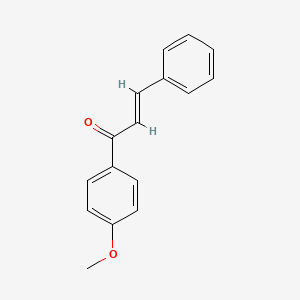
|
4'-Methoxychalcone |
4'-Methoxychalcone is a lipid of Polyketides (PK) class. |
15 |
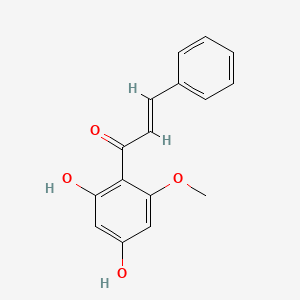
|
Cardamonin |
Cardamonin is a lipid of Polyketides (PK) class. Cardamonin is associated with abnormalities such as Septicemia, endothelial dysfunction, Hypertensive disease, Morphologically altered structure and Disintegration. The involved functions are known as Phosphorylation, Transcriptional Activation, Cell secretion, Canonical Wnt Signaling Pathway and Signal Transduction. Cardamonin often locates in Extracellular, Body tissue, IkappaB kinase complex, Membrane and Muscle, Smooth, Vascular. The associated genes with Cardamonin are ITLN1 gene, Candidate Disease Gene, MTPN gene, Genes, Reporter and PTGS2 gene. The related lipids are Lipopolysaccharides. |
128 |
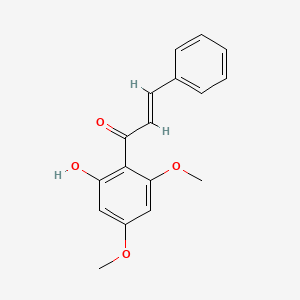
|
Flavokawain b |
Flavokawain b is a lipid of Polyketides (PK) class. Flavokawain b is associated with abnormalities such as Helminthiasis. The involved functions are known as Cell Death and MAPK Signaling Pathway. Flavokawain b often locates in Blood, Entire bony skeleton and Integumentary system. |
74 |
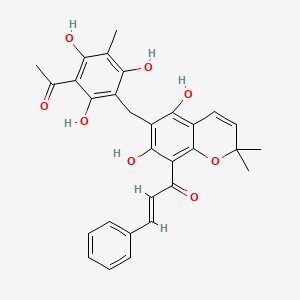
|
rottlerin |
Rottlerin is a lipid of Polyketides (PK) class. Rottlerin is associated with abnormalities such as PARAGANGLIOMAS 2, Hyperostosis, Diffuse Idiopathic Skeletal, Virus Diseases, Perisylvian syndrome and Autoimmune disease (systemic) NOS. The involved functions are known as Apoptosis, Regulation, Signal Transduction, inhibitors and Proteasome Inhibitors [MoA]. Rottlerin often locates in Clone, Membrane, Body tissue, Plasma membrane and soluble. The associated genes with Rottlerin are XIAP gene, GAPDH gene, ICAM1 gene, P4HTM gene and TNFSF10 gene. The related lipids are Promega, Fatty Acids, Sphingolipids, Lipopolysaccharides and Saponin. The related experimental models are Mouse Model, Xenograft Model and Cancer Model. |
1198 |

|
naringenin |
naringenin is a lipid of Polyketides (PK) class. Naringenin is associated with abnormalities such as Dehydration, Papillon-Lefevre Disease, BOSLEY-SALIH-ALORAINY SYNDROME, Cardiovascular Diseases and Atherosclerosis. The involved functions are known as Pigmentation, Biosynthetic Pathways, metaplastic cell transformation, 4-coumarate-CoA ligase activity and Pigment. Naringenin often locates in Body tissue, Cell Wall, Membrane, Cytoplasmic matrix and Tissue membrane. The associated genes with naringenin are Genome, Genes, Regulator, Alleles, Homologous Gene and SPEN gene. The related lipids are Fatty Acids, Total cholesterol, Lipopolysaccharides, Oleates and Cholesterol, Dietary. The related experimental models are Knock-out and Mouse Model. |
2420 |
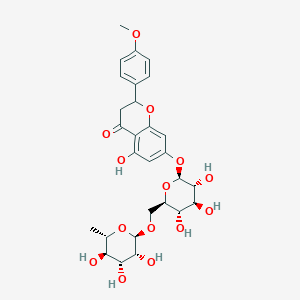
|
MEGxp0_001204 |
MEGxp0_001204 is a lipid of Polyketides (PK) class. |
19 |

|
hesperidin |
(2S)-5-hydroxy-2-(3-hydroxy-4-methoxyphenyl)-4-oxo-3,4-dihydro-2H-chromen-7-yl 6-O-(6-deoxyhexopyranosyl)hexopyranoside is a lipid of Polyketides (PK) class. (2s)-5-hydroxy-2-(3-hydroxy-4-methoxyphenyl)-4-oxo-3,4-dihydro-2h-chromen-7-yl 6-o-(6-deoxyhexopyranosyl)hexopyranoside is associated with abnormalities such as Osteoporosis, Postmenopausal, estrogen deficiency, Chronic venous insufficiency, Neurodegenerative Disorders and Cerebrovascular accident. The involved functions are known as Sweetening Agents, Vmax, enzyme activity, Fermentation and Regulation. (2s)-5-hydroxy-2-(3-hydroxy-4-methoxyphenyl)-4-oxo-3,4-dihydro-2h-chromen-7-yl 6-o-(6-deoxyhexopyranosyl)hexopyranoside often locates in Entire gastrointestinal tract, soluble, Entire bony skeleton, Trabecular substance of bone and Blood. The associated genes with (2S)-5-hydroxy-2-(3-hydroxy-4-methoxyphenyl)-4-oxo-3,4-dihydro-2H-chromen-7-yl 6-O-(6-deoxyhexopyranosyl)hexopyranoside are MTPN gene, GLUCOSIDASE, STN gene, SLC33A1 gene and GHRL gene. The related lipids are Total cholesterol and blood lipid. The related experimental models are Arthritis, Collagen-Induced. |
1455 |
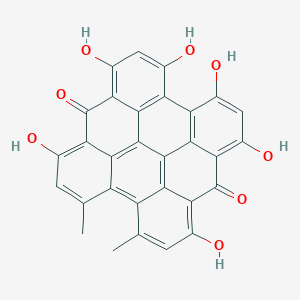
|
hypericin |
hypericin is a lipid of Polyketides (PK) class. Hypericin is associated with abnormalities such as Dermatitis, Phototoxic, Dehydration, Photosensitization, Morphologically altered structure and Myocardial Infarction. The involved functions are known as Cell Cycle Checkpoints, Apoptosis, Acetylation, Cell Survival and Caspase Activation. Hypericin often locates in insoluble fraction, Cytoplasmic matrix, Protoplasm, Tissue membrane and Cytoplasm. The associated genes with hypericin are CDC37 gene, HSPA8 gene, RAF1 gene, cyclin H and FK228. The related lipids are Phosphatidylserines. |
1752 |
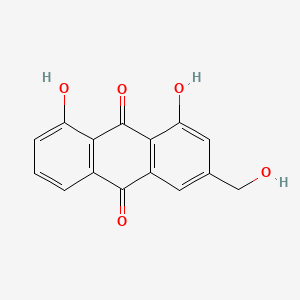
|
Aloe-emodin |
Aloe-emodin is a lipid of Polyketides (PK) class. Aloe-emodin is associated with abnormalities such as Wiskott-Aldrich Syndrome. The involved functions are known as Anabolism, Phosphorylation, Signal Transduction, Cell Proliferation and Cell Survival. Aloe-emodin often locates in Body tissue, Cell Fraction, Mitochondria, Micronucleus and Microsomes, Liver. The associated genes with Aloe-emodin are MECHANISTIC TARGET OF RAPAMYCIN COMPLEX 2, RICTOR gene, PI3 gene, PRR5 gene and MANEA gene. |
451 |

|
emodin |
emodin is a lipid of Polyketides (PK) class. Emodin is associated with abnormalities such as Infection, Conjunctivitis, Vernal, Stevens-Johnson Syndrome, Conjunctival scar and Allergic Conjunctivitis. The involved functions are known as signaling cascade, Metabolic Inhibition, Cell Death, Phosphorylation and JNK Pathway. Emodin often locates in Membrane, Protoplasm, Mitochondria, Cytoplasmic matrix and soluble. The associated genes with emodin are cytochrome c'', UTS2 gene, TK Gene, Gene Clusters and CFC1 gene. The related lipids are Phosphatidylserines, Promega, Sphingolipids, Membrane Lipids and Palmitates. The related experimental models are Mouse Model and Transgenic Model. |
1742 |
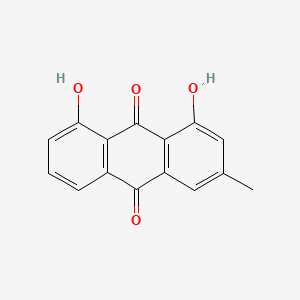
|
Chrysophanol |
Chrysophanol is a lipid of Polyketides (PK) class. Chrysophanol is associated with abnormalities such as Wiskott-Aldrich Syndrome. The involved functions are known as Diastasis and Analyte. |
351 |
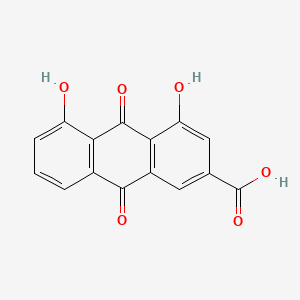
|
Rhein |
Rhein is a lipid of Polyketides (PK) class. Rhein is associated with abnormalities such as Obesity, Non-alcoholic Fatty Liver Disease, Dyslipidemias, Fatty Liver and Degenerative polyarthritis. The involved functions are known as Adipogenesis, Insulin Resistance, luciferase activity, Transcription, Genetic and Inflammation. Rhein often locates in Hepatic, Brown Fat, Muscle, Mouse Liver and Mitochondria. The associated genes with Rhein are QRSL1 gene, Candidate Disease Gene, CFB gene, STAT6 gene and GATA3 gene. The related lipids are Fatty Acids. |
986 |

|
doxorubicin |
Adriamycin is a lipid of Polyketides (PK) class. Adriamycin is associated with abnormalities such as Cardiomyopathies. The involved functions are known as Transcription, Genetic, Process, Drug effect disorder, Diastasis and Oxidation-Reduction. Adriamycin often locates in Muscle, Myocardium and Entire gastrointestinal tract. |
54913 |

|
Megestrol acetate |
Megestrol acetate is a lipid of Sterol Lipids (ST) class. Megestrol acetate is associated with abnormalities such as Anorexia, Malnutrition, HIV Infections, Thrombocytopenia and Exanthema. The involved functions are known as Bleeding of vagina, Agent, Cell Survival, Cytopenia and Regulation. The associated genes with Megestrol acetate are Genome. The related lipids are Steroids. The related experimental models are Xenograft Model. |
866 |

|
(-)-Perillyl alcohol |
(-)-perillyl alcohol is a lipid of Prenol Lipids (PR) class. The involved functions are known as Cell Cycle Progression, Cell Cycle, Cell Proliferation, Apoptosis and Isoprenylation. (-)-perillyl alcohol often locates in Cytoplasm, Membrane and Plasma membrane. The associated genes with (-)-Perillyl alcohol are JUN gene, Candidate Disease Gene, IL24 gene, BCL2L1 gene and CFB gene. The related experimental models are Transgenic Model. |
299 |
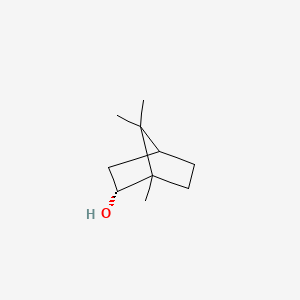
|
(-)-Borneol |
(-)-borneol is a lipid of Prenol Lipids (PR) class. The involved functions are known as Protein-Protein Interaction. |
355 |
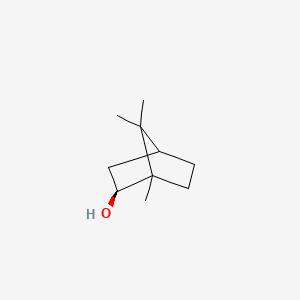
|
(+)-borneol |
(+)-borneol is a lipid of Prenol Lipids (PR) class. |
211 |

















































